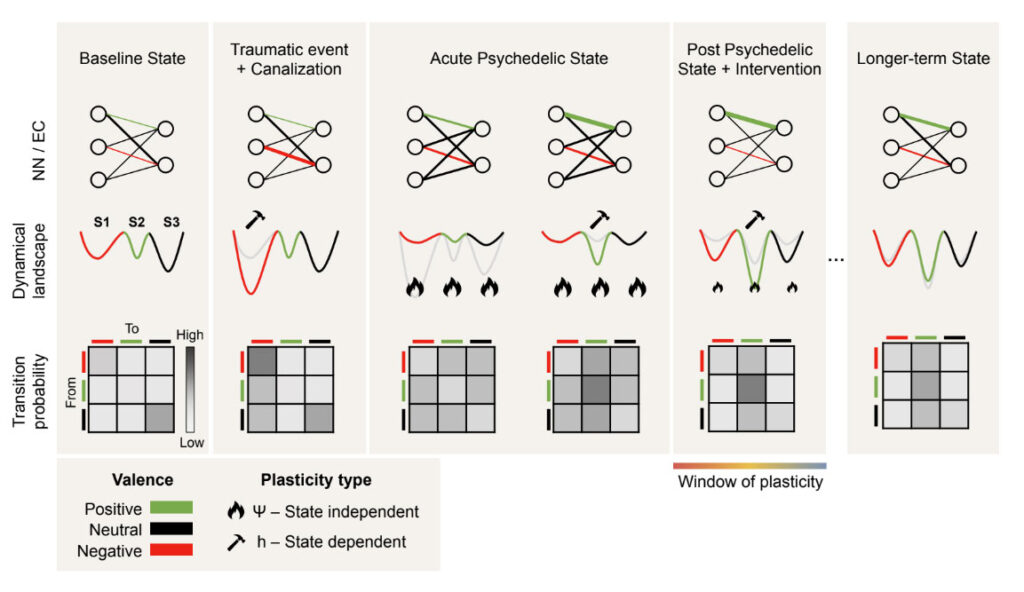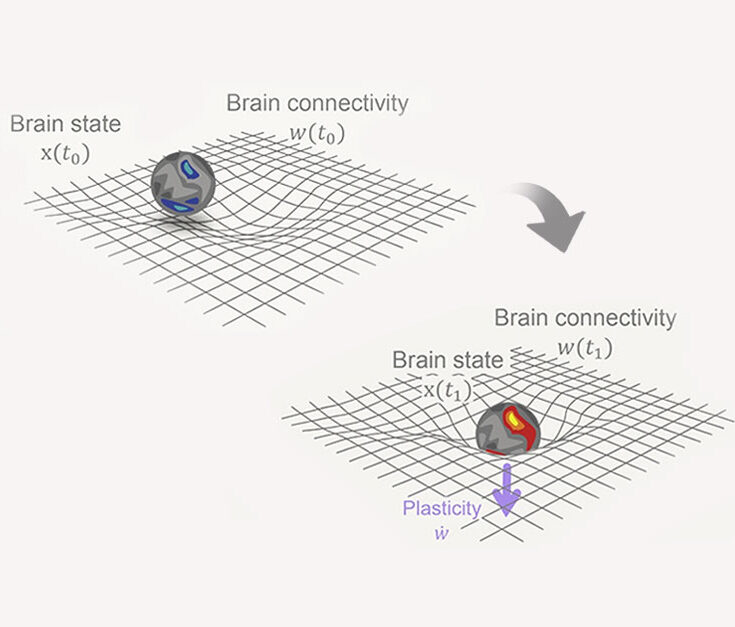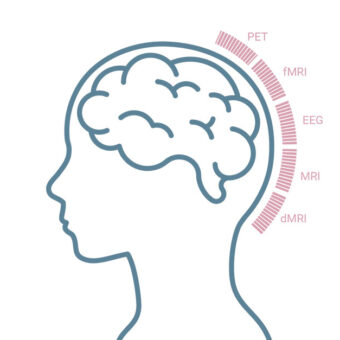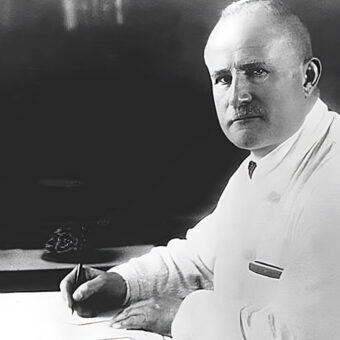The intersection of brain dynamics, plasticity, and psychedelics is a subject of endless fascination, and recent research has cast a new light on this complex interplay. At the forefront of this exploration is the concept of neural geometrodynamics, a groundbreaking theory that draws parallels with the fundamentals of general relativity.
Neural Geometrodynamics: Decoding the Brain’s Language
In this paper [1], we uncover a revolutionary approach to understanding the brain’s complexities. This concept transcends traditional views of neural function, proposing a dynamic interplay between the brain’s structure and its operations, akin to the relationship between spacetime and matter in general relativity. Just as matter influences the curvature of spacetime, neural activity, and brain structure are interrelated, with each shaping the other: brain states are influenced by the existing neural connections, and reciprocally, they dynamically modify the neural connectivity through the mechanisms of plasticity. This analogy provides a compelling framework to understand the brain’s operations, painting a picture where thoughts, emotions, and experiences bend and shape the neural landscape.

This paper formalizes key mathematical concepts essential for a deeper understanding of neural dynamics, specifically focusing on the dynamics of brain states, plasticity, and metaplasticity. It provides a detailed analysis of the different timescales at which these processes operate: brain states fluctuate rapidly, plastic changes of the brain connectivity occur at a slower rate, and metaplasticity (changes in plasticity) evolves over an even longer duration. This stratified temporal framework offers a thorough perspective on the adaptive mechanisms of the brain.
In the Neural Geometrodynamics (NGD) framework, two distinct forms of plasticity are identified: state-dependent and state-independent. State-dependent plasticity relies on the current state of the brain, similar to the mechanism seen in Hebbian plasticity, which is vital for learning processes. It adapts based on the brain’s ongoing activities and experiences. On the other hand, state-independent plasticity functions independently of the brain’s current state, offering a unique mode of neural adaptation that does not directly hinge on immediate neural activities or experiences.
Psychedelics: Unlocking New Neural Pathways
Psychedelics, often surrounded by mystery and debate, have gained significant attention in neuroscience for their substantial influence on brain dynamics. Substances like LSD and psilocybin are now recognized for their ability to catalyze significant changes in neural functioning. Chief among these is the induction of heightened neural entropy, leading to increased complexity in brain activity. This ‘landscape flattening’ effect reduces the brain’s hierarchical structures, fostering a more homogenous and less constrained neural environment. The REBUS model [2] elucidates this process, suggesting that psychedelics disrupt the brain’s predictive coding and entrenched belief systems. This temporary relaxation of cognitive patterns offers a window for mental exploration and therapeutic intervention, hinting at new treatments for various mental health disorders.
The formalization in the Neural geometrodynamics framework of plasticity and metaplasticity dynamics becomes particularly relevant in understanding how psychedelics impact the brain, as they primarily induce state-independent plasticity during their acute phase, thereby facilitating a unique period of significant brain flexibility. This change leads to the exploration of a wider range of neural states and the formation of new neural pathways and attractors. As the effects of psychedelics diminish, the brain gradually reverts towards its baseline state, yet retains lasting changes from new connections formed in this heightened state of plasticity. This post-acute phase is characterized as a “window of enhanced plasticity,” where the brain remains more susceptible to internal and external influences, suggesting the potential for long-lasting therapeutic effects.

Enhancing this understanding, the paper proposes an analogy with space-time wormholes. In this context, psychedelics may create new neural pathways akin to wormholes, bridging connections between usually distant brain regions. This effect is particularly significant in conditions where brain dynamics are entrenched or stuck, as seen in depression. The CANAL and deep CANAL frameworks [3, 4] provide valuable insights into how these entrenched dynamics develop and persist in depressive states. The Neural Geometrodynamics framework emphasizes that psychedelics can disrupt these rigid patterns, leading to profound changes in mental states. This disruption of entrenched dynamics is key to understanding the potential therapeutic effects of psychedelics in treating mental health disorders.

Conclusion: Transforming Neuroscience through Neural Geometrodynamics
To conclude, the findings in this paper represent a pivotal advance in our ongoing journey to understand the complex mechanisms of the human brain. The Neural Geometrodynamics framework, inspired by the interplay of spacetime and matter in general relativity, delves deep into the nuances of neural dynamics, complexity, and plasticity. While the paper primarily discusses psychedelics, it’s important to note that the Neural Geometrodynamics framework also offers valuable insights into other alterations in brain dynamics, as seen in treatments like Transcranial Magnetic Stimulation (TMS) or transcranial Electrical Stimulation (tES). This research holds the potential to redefine our understanding of the brain and pave the way for transformative approaches to mental health. The journey has just begun, and the possibilities are as vast as the neural landscape itself.



